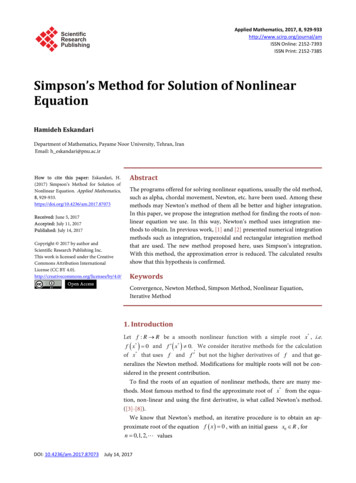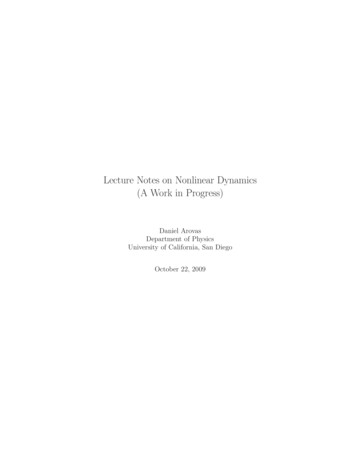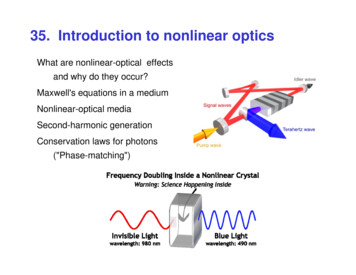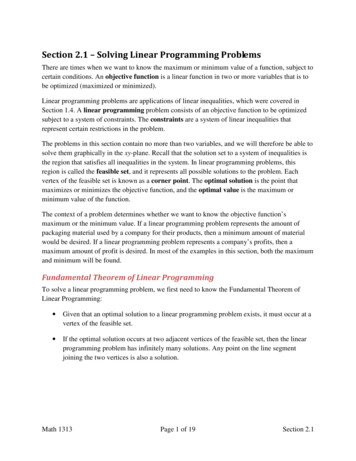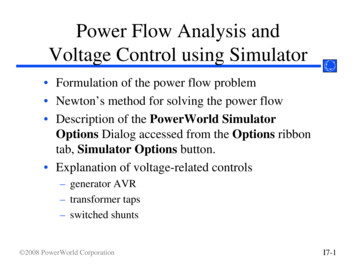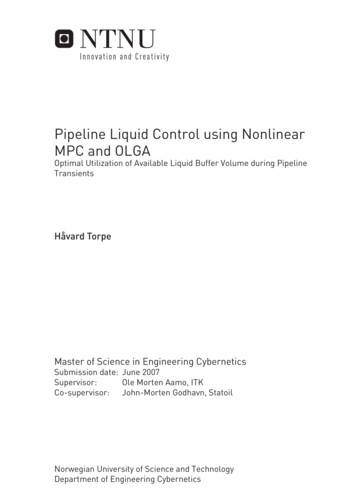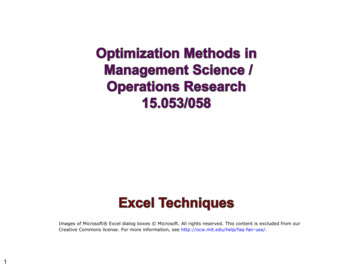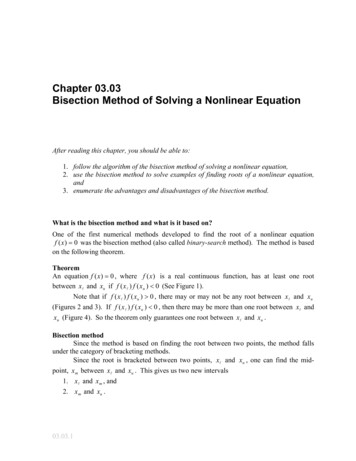
Transcription
Chapter 03.03Bisection Method of Solving a Nonlinear EquationAfter reading this chapter, you should be able to:1. follow the algorithm of the bisection method of solving a nonlinear equation,2. use the bisection method to solve examples of finding roots of a nonlinear equation,and3. enumerate the advantages and disadvantages of the bisection method.What is the bisection method and what is it based on?One of the first numerical methods developed to find the root of a nonlinear equationf ( x) 0 was the bisection method (also called binary-search method). The method is basedon the following theorem.TheoremAn equation f ( x) 0 , where f (x) is a real continuous function, has at least one rootbetween x and xu if f ( x ) f ( xu ) 0 (See Figure 1).Note that if f ( x ) f ( xu ) 0 , there may or may not be any root between x and xu(Figures 2 and 3). If f ( x ) f ( xu ) 0 , then there may be more than one root between x andxu (Figure 4). So the theorem only guarantees one root between x and xu .Bisection methodSince the method is based on finding the root between two points, the method fallsunder the category of bracketing methods.Since the root is bracketed between two points, x and xu , one can find the midpoint, x m between x and xu . This gives us two new intervals1. x and x m , and2. x m and xu .03.03.1
03.03.2Chapter 03.03f (x)xℓxxuFigure 1 At least one root exists between the two points if the function is real, continuous,and changes sign.f (x)xℓxuxFigure 2If the function f (x) does not change sign between the two points, roots of theequation f ( x) 0 may still exist between the two points.
Bisection Method03.03.3f (x)f (x)xℓxℓ xuxxuxFigure 3 If the function f (x) does not change sign between two points, there may not beany roots for the equation f ( x) 0 between the two points.f (x)xℓxuxFigure 4 If the function f (x) changes sign between the two points, more than one root forthe equation f ( x) 0 may exist between the two points.Is the root now between x and x m or between x m and xu ? Well, one can find the sign off ( x ) f ( x m ) , and if f ( x ) f ( x m ) 0 then the new bracket is between x and x m , otherwise,it is between x m and xu . So, you can see that you are literally halving the interval. As onerepeats this process, the width of the interval [x , xu ] becomes smaller and smaller, and youcan zero in to the root of the equation f ( x) 0 . The algorithm for the bisection method isgiven as follows.
03.03.4Chapter 03.03Algorithm for the bisection methodThe steps to apply the bisection method to find the root of the equation f ( x) 0 are1. Choose x and xu as two guesses for the root such that f ( x ) f ( xu ) 0 , or in otherwords, f (x) changes sign between x and xu .2. Estimate the root, x m , of the equation f ( x) 0 as the mid-point between x and xuasx xuxm 23. Now check the followinga) If f ( x ) f ( x m ) 0 , then the root lies between x and x m ; then x x andxu x m .b) If f ( x ) f ( x m ) 0 , then the root lies between x m and xu ; then x x m andxu xu .c) If f ( x ) f ( x m ) 0 ; then the root is x m . Stop the algorithm if this is true.4. Find the new estimate of the rootx xuxm 2Find the absolute relative approximate error asxmnew - xmold a 100xmnewwherexmnew estimated root from present iterationxmold estimated root from previous iteration5. Compare the absolute relative approximate error a with the pre-specified relativeerror tolerance s . If a s , then go to Step 3, else stop the algorithm. Note oneshould also check whether the number of iterations is more than the maximumnumber of iterations allowed. If so, one needs to terminate the algorithm and notifythe user about it.Example 1You are working for ‘DOWN THE TOILET COMPANY’ that makes floats for ABCcommodes. The floating ball has a specific gravity of 0.6 and has a radius of 5.5 cm. Youare asked to find the depth to which the ball is submerged when floating in water.The equation that gives the depth x to which the ball is submerged under water is given byx 3 0.165 x 2 3.993 10 4 0Use the bisection method of finding roots of equations to find the depth x to which the ballis submerged under water. Conduct three iterations to estimate the root of the aboveequation. Find the absolute relative approximate error at the end of each iteration, and thenumber of significant digits at least correct at the end of each iteration.
Bisection Method03.03.5SolutionFrom the physics of the problem, the ball would be submerged between x 0 and x 2 R ,whereR radius of the ball,that is0 x 2R0 x 2(0.055)0 x 0.11Figure 5 Floating ball problem.Lets us assumex 0, xu 0.11Check if the function changes sign between x and xu .f ( x ) f (0) (0) 3 0.165(0) 2 3.993 10 4 3.993 10 4Hencef ( xu ) f (0.11) (0.11) 3 0.165(0.11) 2 3.993 10 4 2.662 10 4f ( x ) f ( xu ) f (0) f (0.11) (3.993 10 4 )( 2.662 10 4 ) 0So there is at least one root between x and xu , that is between 0 and 0.11.Iteration 1The estimate of the root isx xuxm 20 0.11 2 0.05532f ( x m ) f (0.055) (0.055) 0.165(0.055) 3.993 10 4 6.655 10 5()()f ( x ) f ( xm ) f (0) f (0.055) 3.993 10 4 6.655 10 4 0
03.03.6Chapter 03.03Hence the root is bracketed between x m and xu , that is, between 0.055 and 0.11. So, thelower and upper limit of the new bracket isx 0.055, xu 0.11At this point, the absolute relative approximate error a cannot be calculated as we do nothave a previous approximation.Iteration 2The estimate of the root isx xuxm 20.055 0.11 2 0.0825f ( xm ) f (0.0825) (0.0825) 3 0.165(0.0825) 2 3.993 10 4 1.622 10 4() ()f ( x ) f ( x m ) f (0.055) f (0.0825) 6.655 10 5 1.622 10 4 0Hence, the root is bracketed between x and x m , that is, between 0.055 and 0.0825. So thelower and upper limit of the new bracket isx 0.055, xu 0.0825The absolute relative approximate error a at the end of Iteration 2 is a xmnew xmold 100xmnew0.0825 0.055 1000.0825 33.33%None of the significant digits are at least correct in the estimated root of x m 0.0825because the absolute relative approximate error is greater than 5%.Iteration 3x xuxm 20.055 0.0825 2 0.06875f ( xm ) f (0.06875) (0.06875) 3 0.165(0.06875) 2 3.993 10 4 5.563 10 5 f ( x ) f ( xm ) f (0.055) f (0.06875) (6.655 105 ) ( 5.563 10 5 ) 0Hence, the root is bracketed between x and x m , that is, between 0.055 and 0.06875. So thelower and upper limit of the new bracket isx 0.055, xu 0.06875The absolute relative approximate error a at the ends of Iteration 3 is
Bisection Method a 03.03.7xmnew xmold 100xmnew0.06875 0.0825 1000.06875 20%Still none of the significant digits are at least correct in the estimated root of the equation asthe absolute relative approximate error is greater than 5%.Seven more iterations were conducted and these iterations are shown in Table 1. Table 1 Root of f ( x) 0 as function of number of iterations for bisection method.xuxmf (xm ) a %x Iteration10.00000 0.110.055---------6.655 10 520.0550.110.0825 33.33 1.622 10 430.0550.0825 0.06875 20.00 5.563 10 540.0550.06875 0.06188 11.114.484 10 650.06188 0.06875 0.06531 5.263 2.593 10 560.06188 0.06531 0.06359 2.702 1.0804 10 570.06188 0.06359 0.06273 1.370 3.176 10 680.06188 0.06273 0.0623 0.68976.497 10 790.0623 0.06273 0.06252 0.3436 1.265 10 6100.0623 0.06252 0.06241 0.1721 3.0768 10 7At the end of 10th iteration, a 0.1721%Hence the number of significant digits at least correct is given by the largest value of m forwhich a 0.5 10 2 m0.1721 0.5 10 2 m0.3442 10 2 mlog(0.3442) 2 mm 2 log(0.3442) 2.463Som 2The number of significant digits at least correct in the estimated root of 0.06241 at the end ofthe 10 th iteration is 2.Advantages of bisection methoda) The bisection method is always convergent. Since the method brackets the root,the method is guaranteed to converge.b) As iterations are conducted, the interval gets halved. So one can guarantee theerror in the solution of the equation.
03.03.8Chapter 03.03Drawbacks of bisection methoda) The convergence of the bisection method is slow as it is simply based on halvingthe interval.b) If one of the initial guesses is closer to the root, it will take larger number ofiterations to reach the root.c) If a function f (x) is such that it just touches the x -axis (Figure 6) such asf ( x) x 2 0it will be unable to find the lower guess, x , and upper guess, xu , such thatf ( x ) f ( xu ) 0d) For functions f (x) where there is a singularity 1 and it reverses sign at thesingularity, the bisection method may converge on the singularity (Figure 7). Anexample includes1f ( x) xwhere x 2 , xu 3 are valid initial guesses which satisfyf ( x ) f ( xu ) 0However, the function is not continuous and the theorem that a root exists is alsonot applicable.f (x)xFigure 6 The equation f ( x) x 2 0 has a single root at x 0 that cannot be bracketed.1A singularity in a function is defined as a point where the function becomes infinite. For example, for a functionsuch as 1 / x , the point of singularity is x 0 as it becomes infinite.
Bisection Method03.03.9f (x)xFigure 7 The equation f ( x ) 1 0 has no root but changes sign.xNONLINEAR EQUATIONSTopicBisection method of solving a nonlinear equationSummary These are textbook notes of bisection method of finding roots ofnonlinear equation, including convergence and pitfalls.MajorGeneral EngineeringAuthorsAutar KawDateJanuary 15, 2012Web Site http://numericalmethods.eng.usf.edu
03.03.1 . Chapter 03.03 Bisection Method of Solving a Nonlinear Equation . After reading this chapter, you should be able to: 1. follow the algorithm of the bisection method of solving a nonlinear equation,
